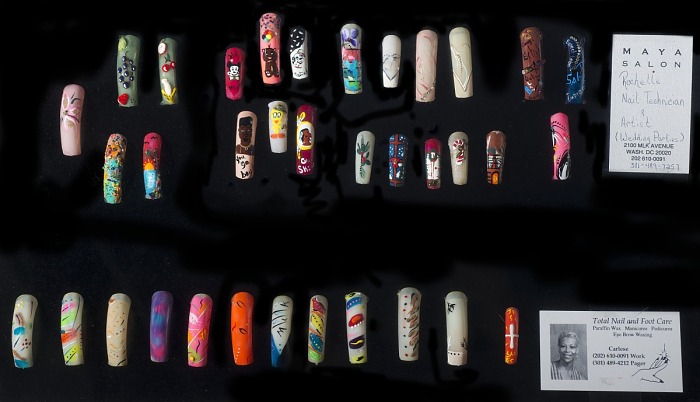Hello there, ID 242 and other prospective readers. I will present some introductory information on the Anacostia Community Museum. Here is the video link:
First, Anacostia is one of Washington, D.C.’s oldest neighborhoods, originally called Uniontown. It brims with African American history and culture, especially in the Anacostia Historic District. For example, Frederick Douglass’s house, Cedar Hills, is run by the National Park Service. Other popular venues include Anacostia Playhouse and the Anacostia Arts Center.

A collection of locally produced acrylic nails for advertisement.
A Smithsonian Museum despite its name, the ACM was opened in 1967 as the first federal museum outreach to African Americans. The museum emphasized educational art and cultural offerings to local schools and adults. Additionally, the museum contained a hands-on children’s room and possessed a youth advisory council. In the 1980s, the museum started programs to preserve church archives and family histories. When the National Museum of African American History was established in 2003, the ACM’s focus shifted somewhat from mostly the local community’s history to more globally minded topics.
The ACM currently focuses on studying urban challenges and highlighting local life, which includes immigrants. Exhibits focus on human stories and cooperation between curators and creators, and residents, local officials, activists, artists, businesses, families, and others. Its collections contain thousands of unique artifacts related to the local African American community, like family archives of 19th-century African American locals to works from black DC artists. The museum is not just about the surrounding community, but utterly linked to it. Recent projects have included documentation, exhibitions and public programs, the development of Washington, D.C. neighborhoods east of the Anacostia River, et cetera. Most of these projects include extensive community engagement, photographic documentation, collection efforts, and extensive oral history documentation. Much of this work falls under the museum’s Community Documentation Initiative.
The ACM examines the intimate history, the present filled with both problems and opportunities, and the hopeful future of Anacostia. Individual and small-scale stories have a great chance of overlap because the museum’s focus is so locally charged, which strengthens their context and emotional impact through solidarity. Here’s a quote summing up the ACM’s mission and purpose: “ACM documents and preserves communities’ memories, struggles, and successes, and offers a platform where diverse voices and cultures can be heard. We believe that bridging disparate parts of our communities can bring collective action to bear on forging a better future together.”
Next up are the museum’s values and commitments. The ACM particularly relies on the experiences and skills of local collaborators, which helps tie the history forward into the present day, and gives visitors a better feel for Anacostia’s web of personal and cultural connections. I gleaned the exact list from the official website. The ACM values inclusivity, creativity, trust, empowerment, and collaboration. Commitments include sharing authority with and respecting community collaborators, using a local lens that focuses on the people’s voices to tell their story, fostering connection among D.C. residents, providing for inclusive idea-sharing, and inspiring sustained civic engagement.
Our consultant is Dr. Samir Meghelli, who obtained his M.A., M.Phil., and Ph.D. in History from Columbia University. He’s a Historian, writer, educator, and chief curator at the ACM. Meghelli is a visiting Scholar-in-Residence (2019-2022) at American University’s Metropolitan Policy Center in the Department of Public Policy & Administration. Dr. Meghelli focuses on social movements, urban history, and cultural history, and is involved with many documentaries, museum exhibitions, community history and research projects. His writings have appeared in various books, newspapers, and scholarly journals, including The New York Times, The Philadelphia Tribune, The Washington Informer, Black Arts Quarterly, and The Western Journal of Black Studies.
Here are two questions. Firstly: How does the ACM balance the wishes of local workers and its capacities, funding, and expectations as a Smithsonian museum; are there a lot of compromises to be made, or have the goals largely meshed? Secondly: You work on documentaries, museum exhibitions, community history and research projects, as well as writing articles. How might these different facets of work intersect, and connect community members and collaborators- are there significant logistic pros and cons to certain avenues of outreach?
Hopefully, this post serves to inform you of a very interesting museum.
